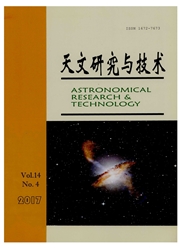

 中文摘要:
中文摘要:
收集了142个射电类星体(28个射电宁静类星体、114个射电噪类星体)、43个核占优型射电类星体、82个瓣占优型射电类星体和80个Seyfert星系的样本,基于Logistic非线性回归分析的方法对红移和热光度、黑洞质量、5GHz射电光度、爱丁顿吸积率、核主导参数尺的关系进行研究,拟合出相应的演化曲线,得到如下结论:(1)射电类星体的演化是从射电噪类星体(RLQ)演化到射电宁静类星体(RQQ),当演化到一定阶段射电类星体过渡到Seyfert星系;(2)核占优型射电类星体(CDQ)和瓣占优型射电类星体(LDQ)之间并没有明显的随红移演化。
 英文摘要:
英文摘要:
In this paper, we collect samples of 142 radio quasars (28 radio-quiet quasars and 114 radio- loud quasars) , 43 core-dominated quasars, 82 lobe-dominated quasars, and 80 Seyfert galaxies. Based on the Logistic Regression, we analyze the relations of black-hole mass estimates, radio luminosities in 5GHz, Eddington rates, and core-dominated parameter (R) values versus redshifls. We also fit the corresponding evolution curves. Our conclusions are as follows. ( 1 ) The evolution of radio quasars is from radio-loud quasars (RLQ) to radio-quiet quasars (RQQ), and at certain stage the transition is from radio quasars to Seyfert galaxies (possibly because energy from accretion cannot maintain the accretion process carsing quasar activities to decline). This supports the view that the differences between RLQ and RQQ are not due to the orientation effect but are results of evolution, and our conclusions confirm the evolution scenario from quasars to Seyfert galaxies proposed by Punsly (1996) and Park ( 1988 ). It can explain why RLQs, which tend to have high redshifts, high luminosities, and high accretion rates, likely appear in the early stage of the universe, but all these properties show decrease trends with redshifts and quasar activities began to decline. (2) Core-dominated quasars and lobe-dominated quasars do not show obvious evolution.
 同期刊论文项目
同期刊论文项目
 同项目期刊论文
同项目期刊论文
 :Zhang X, Fermi gamma-ray and multi-wave band emission from T eV active galactic nuclei , 2012,AP&am
:Zhang X, Fermi gamma-ray and multi-wave band emission from T eV active galactic nuclei , 2012,AP&am 期刊信息
期刊信息
